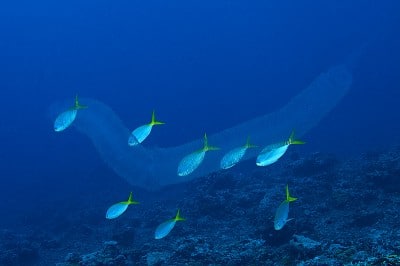Several of us have encountered a free-floating colonial tunicate during our dives on leeward reefs. Known as Pyrosomes (from the Greek, pyro = fire and soma = body), these unusual tunicates consist of cylindrical- or conical-shaped colonies made up of hundreds to thousands of zooids. While some are only a few cm in length, the ones we’ve seen have been over a meter in length. Their name comes from their bioluminescence, a pale blue-green light that is emitted in waves as each individual zooid detects light and emits light in response.
Like other tunicates, the individual zooids (each a few mm in size) are embedded in a gelatinous tunic, and are all joined together. Each zooid has two siphons, one opens to the inside and the other to the outside of the tube.
Large scale movements of these animals are largely controlled by currents, tides, and waves. Pyrosomes can also move through the water column slowly by the process of jet propulsion created by the coordinated beating of cilia in their branchial baskets. This process also aids in feeding.
Photo by Ken Marks.

